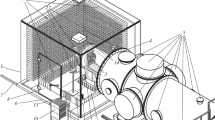Abstract
Primary approaches are considered for the development of emission simulators from electric propulsion thrusters (EPTs) in the radio-frequency range, including both the use of the stored actual member functions for the processes characterizing the EPT emission in the specified frequency ranges and the processes that are formed on the basis of emission simulation models. Various approaches to emission simulation modeling from stationary plasma thrusters are discussed. A possibility to use the earlier-developed mathematical models and software packages to simulate the EPT emission is considered; these models describe the complex envelope of the emission processes from a stationary plasma thruster in the given frequency ranges. Primary principles for the development of the radio simulators of the wanted signals and interference are also discussed. The application of multichannel vector generators is substantiated in view of the growth in complexity of simulated signals and interference. In such generators, the quadrature components of the processes describing EPT emission are employed that were obtained by test or by the simulation modeling methods. As an example, the simulator for EPT emission in the radio-frequency range is studied. This simulator provides such an electromagnetic environment in the given spatial region that takes various combinations of valid signals, thermal noises, and EPT emission into consideration. Recommendations are proposed on the use of the emission simulator as a part of the ground modeling complexes for defining possible influence of EPTs on onboard spacecraft systems.
Similar content being viewed by others
References
N. A. Vazhenin, V. A. Obukhov, A. P. Plokhikh, and G. A. Popov, Electric Rocket Thrusters of Spacecraft and Their Effect on Space Communication Radiosystems (Fizmatlit, Moscow, 2013) [in Russian].
N. A. Vazhenin and A. P. Plokhikh, “Simulation modeling for the electromagnetic emission from stationary plasma thrusters,” Izv. Ross. Akad. Nauk. Energ., No. 6, 118–131 (2014).
N. A. Vazhenin, A. P. Plokhikh, “Software for modeling the self-radiation of stationary plasma engines,” State Registration Certificate of Computer Program No. 2015616679 of June 18, 2015.
N. A. Vazhenin, A. P. Plokhikh, and A. I. Fomenkov, “Verification of models and bundled software for simulation modeling of electromagnetic emission from stationary plasma thrusters,” Izv. Ross. Akad. Nauk. Energ., No. 3, 62–73 (2017).
D. Middleton, “Statistical-physical models of electromagnetic interference,” IEEE Trans. Electromagn. Compat. 19 (3), 106–127 (1977).
D. Middleton, “Procedures for determining the parameters of the first-order canonical models of Class A and Class B electromagnetic interference,” IEEE Trans. Electromagn. Compat. 21 (3), 190–208 (1979).
L. S. Proselkov and A. N. Kravchenko, “Radiosignal imitator,” RF Patent No. 2207586, Byull. Izobret., No. 18 (2003).
V. V. Belyaev, A. A. Buben’shchikov, and S. V. Sidenko, “Radio radiation source imitator,” RF Patent No. 2591045, Byull. Izobret., No. 19 (2016).
E. I. Kubov and A. I. Boldyrev, “The use of vector generators in the field of radiomonitoring and information protection,” Spets. Tekh., No. 1, 21–40 (2007).
V. A. Silant’ev, “The use of vector generators in the field of radiomonitoring,” Spets. Tekh., No. 5, 31–40 (2002).
Author information
Authors and Affiliations
Corresponding author
Additional information
Original Russian Text © N.A. Vazhenin, A.P. Plokhikh, G.A. Popov, 2018, published in Izvestiya Rossiiskoi Akademii Nauk, Energetika.
Rights and permissions
About this article
Cite this article
Vazhenin, N.A., Plokhikh, A.P. & Popov, G.A. Simulator of Emission from Electric Propulsion Thrusters. Therm. Eng. 65, 1002–1008 (2018). https://doi.org/10.1134/S004060151813013X
Received:
Published:
Issue Date:
DOI: https://doi.org/10.1134/S004060151813013X




